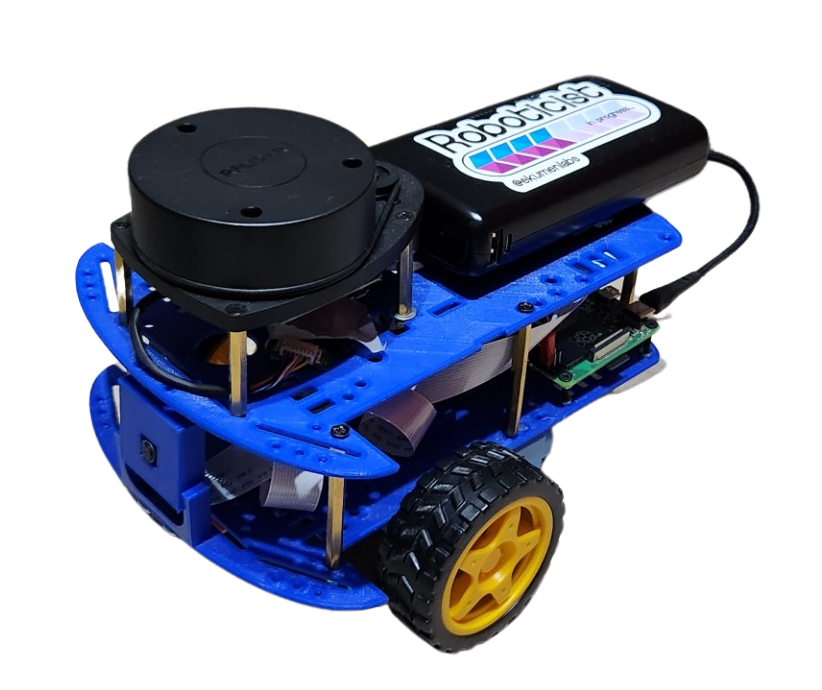Andino is a fully open-source diff drive robot designed for educational purposes and low-cost applications. It is fully integrated with ROS 2 and it is a great base platform to improve skills over the robotics field. With its open-source design, anyone can modify and customize the robot to suit their specific needs.
Note: For videos go to Media section.
- 🚀
andino_bringup: Contains mainly launch files in order to launch all related driver and nodes to be used in the real robot. - 🤖
andino_hardware: Contains information about the Andino assembly and hardware parts. - 📒
andino_description: Contains the URDF description of the robot. - ⚒️
andino_firmware: Contains the code be run in the microcontroller for interfacing low level hardware with the SBC. - ⚙️
andino_base: ROS Control hardware interface is implemented. - 🎛️
andino_control: It launches thecontroller_manageralong with the ros2 controllers: diff_drive_controller and the joint_state_broadcaster. - 💻
andino_gz_classic: Gazebo Classic simulation of theandinorobot. - 🗺️
andino_slam: Provides support for SLAM with yourandinorobot. - 🧭
andino_navigation: Navigation stack based onnav2. - ❗
andino_apps: Integrated applications with theandinorobot.
Other projects built upon Andino! 🚀
- 💻
andino_gz: Gazebo(non-classic) simulation of theandinorobot. - 🐞
andino_webots: Webots simulation of the Andino robot fully integrated with ROS 2. - 🕹️
andino_o3de: O3DE simulation of the Andino robot. - 🟢
andino_isaac: Isaac Sim simulation of the Andino robot. - 🧪
andino_integration_tests: Extension to the Andino robot showing how to build integration tests.
![]() Join our Discord and contribute to the community!
Join our Discord and contribute to the community!
Visit andino_hardware for assembly instructions.
- ROS 2: Humble Hawksbill
- OS:
- Ubuntu 22.04 Jammy Jellyfish
- Ubuntu Mate 22.04 (On real robot (e.g: Raspberry Pi 4B))
Packages here provided are colcon packages. As such a colcon workspace is expected:
- Create colcon workspace
mkdir -p ~/ws/src
- Clone this repository in the
srcfolder
cd ~/ws/src
git clone https://github.com/Ekumen-OS/andino.git
- Install dependencies via
rosdep
cd ~/ws
rosdep install --from-paths src --ignore-src -i -y
- Build the packages
colcon build
- Finally, source the built packages
If using
bash:
source install/setup.bash
Note: Whether your are installing the packages in your dev machine or in your robot the procedure is the same.
The packages have been also released via ROS package manager system for the 'humble' distro. You can check them here.
These packages can be installed using apt (e.g: sudo apt install ros-humble-andino-description) or using rosdep.
andino_bringup contains launch files that concentrates the process that brings up the robot.
After installing and sourcing the andino's packages simply run.
ros2 launch andino_bringup andino_robot.launch.py
This launch files initializes the differential drive controller and brings ups the system to interface with ROS.
By default sensors like the camera and the lidar are initialized. This can be disabled via arguments and manage each initialization separately. See ros2 launch andino_bringup andino_robot.launch.py -s for checking out the arguments.
- include_rplidar:
trueas default. - include_camera:
trueas default.
After the robot is launched, use ROS 2 CLI for inspecting environment.
For example, by doing ros2 topic list the available topics can be displayed:
/camera_info
/cmd_vel
/image_raw
/odom
/robot_description
/scan
/tf
/tf_static
Note: Showing just some of them
Launch files for using the keyboard or a joystick for teleoperating the robot are provided.
ros2 launch andino_bringup teleop_keyboard.launch.py
This is similarly to just executing ros2 run teleop_twist_keyboard teleop_twist_keyboard.
Using a joystick for teleoperating is notably better. You need the joystick configured as explained here.
ros2 launch andino_bringup teleop_joystick.launch.py
Use:
ros2 launch andino_bringup rviz.launch.py
For starting rviz2 visualization with a provided configuration.
The andino_navigation package provides a navigation stack based on the great Nav2 package.
andino_sim_nav.mp4
Follow the andino_navigation's README instructions for bringing up the Navigation stack in the real robot or in the simulation.
The andino_gz_classic package provides a Gazebo simulation for the Andino robot.
andino_wheel_tf.mp4
Using the robot for mapping.
andino_slam_office.mp4
slam_cam_house.mp4
See andino_slam for more information.
Have you built your Andino already? Please go to Show & Tell Discussion and share with us your own version of it.
This section is dedicated to recognizing and expressing gratitude to the open-source repositories that have served as a source of inspiration for this project. We highly recommend exploring these repositories for further inspiration and learning.
Issues or PRs are always welcome! Please refer to CONTRIBUTING doc.
Note that a Docker folder is provided for easy setting up the workspace.

